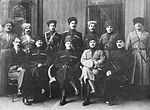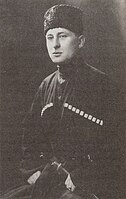Mountainous Republic of the Northern Caucasus
The Mountainous Republic of the Northern Caucasus (MRNC), also referred to as the United Republics of the North Caucasus, Mountain Republic, or the Republic of the Mountaineers, was a state in Eurasia and encompassing the entirety of the North Caucasus that emerged during the Russian Civil War and existed from 1917 to 1922. It formed as a consolidation of various Caucasian ethnic groups, including the Abkhazians, Abazins Circassians, Chechens, Karachays, Ossetians, Balkars, Ingush, and Dagestanis.
Mountainous Republic of the Northern Caucasus
Sunni Islam (majority and state-backed faith)
Russian Orthodox Church (minority)
North Caucasian
Confederated parliamentary republic under a provisional government
6 March 1917
1 May 1917
30 November 1922
1917[1]
1922[2]
430,874 km2 (166,361 sq mi)
11,221,860[8]
The MRNC encompassed the former territories of Terek Oblast and Dagestan Oblast within the Russian Empire. These territories now constitute the present-day republics of Chechnya, Ingushetia, North Ossetia–Alania, Kabardino-Balkaria, Dagestan, and a portion of Stavropol Krai in the Russian Federation. Spanning approximately 430,874 square kilometers (166,361 sq mi), the MRNC had a population of approximately 11.2 million. Throughout its existence, the capital of the MRNC relocated from Vladikavkaz to Nazran and ultimately settled in Temir-Khan-Shura.
The MRNC broke away from the Russian Empire after the February Revolution, just before the outbreak of the Russian Civil War. The Russian Volunteer Army captured the state in 1922, and it ceased to exist.[9] However, in September 1919, the North Caucasian Emirate was proclaimed as the successor of the Mountain Republic.[10] However, in August 1920, it was captured by the Soviet Russia, which led to an uprising.[11] In April 1921, the Mountain Autonomous Soviet Socialist Republic was established by the Bolsheviks within the RSFSR, but the uprising lasted until 1925.[12]
State formation[edit]
The Union consisted seven "states" distributed on a national basis and united under a confederative principle within the territories: Dagestan, Ingushetia, Chechnya, North Ossetia–Alania, Circassia (including West Circassia, although the union had control only over East Circassia), Karachay-Balkaria, the Nogai steppes, and also asserted claims in Abkhazia.[13][14][15]
The Cabinet of Ministers of the Mountain Republic comprised representatives from nearly all regions of the North Caucasus.








![Daniyal Apashev, Member of Parliament and chairman in 1919, Kumyk. Killed by Bolsheviks in 1920.[20]](http://upload.wikimedia.org/wikipedia/commons/thumb/a/a4/%D0%90%D0%BF%D0%B0%D1%88%D0%B5%D0%B2%2C_%D0%94%D0%B0%D0%BD%D0%B8%D1%8F%D0%BB.jpg/126px-%D0%90%D0%BF%D0%B0%D1%88%D0%B5%D0%B2%2C_%D0%94%D0%B0%D0%BD%D0%B8%D1%8F%D0%BB.jpg)
![Ibrahim Bey Gaydarov, Minister of Posts and Telegraph,[21] Lezgian. Died in Ankara in 1949.](http://upload.wikimedia.org/wikipedia/commons/thumb/d/d6/Ibrahim_bey_Haydarov.jpg/150px-Ibrahim_bey_Haydarov.jpg)




